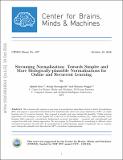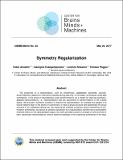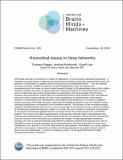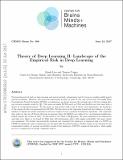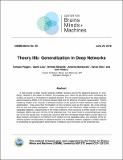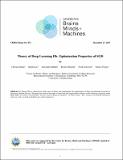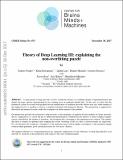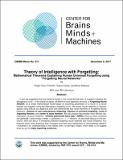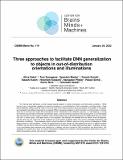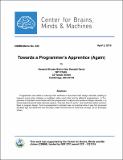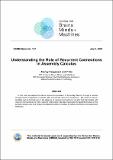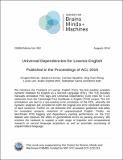Browsing CBMM Memo Series by Title
Now showing items 116-135 of 141
-
Spoken ObjectNet: A Bias-Controlled Spoken Caption Dataset
(Center for Brains, Minds and Machines (CBMM), The 22nd Annual Conference of the International Speech Communication Association (Interspeech), 2021-08-30)Visually-grounded spoken language datasets can enable models to learn cross-modal correspon- dences with very weak supervision. However, modern audio-visual datasets contain biases that un- dermine the real-world performance ... -
Stable Foundations for Learning: a foundational framework for learning theory in both the classical and modern regime.
(Center for Brains, Minds and Machines (CBMM), 2020-03-25)We consider here the class of supervised learning algorithms known as Empirical Risk Minimization (ERM). The classical theory by Vapnik and others characterize universal consistency of ERM in the classical regime in which ... -
Streaming Normalization: Towards Simpler and More Biologically-plausible Normalizations for Online and Recurrent Learning
(Center for Brains, Minds and Machines (CBMM), arXiv, 2016-10-19)We systematically explored a spectrum of normalization algorithms related to Batch Normalization (BN) and propose a generalized formulation that simultaneously solves two major limitations of BN: (1) online learning and ... -
Symmetry Regularization
(Center for Brains, Minds and Machines (CBMM), 2017-05-26)The properties of a representation, such as smoothness, adaptability, generality, equivari- ance/invariance, depend on restrictions imposed during learning. In this paper, we propose using data symmetries, in the sense of ... -
System identification of neural systems: If we got it right, would we know?
(Center for Brains, Minds and Machines (CBMM), 2022-07-02)Various artificial neural networks developed by engineers have been evaluated as models of the brain, such as the ventral stream in the primate visual cortex. After being trained on large datasets, the network outputs are ... -
Theoretical Issues in Deep Networks
(Center for Brains, Minds and Machines (CBMM), 2019-08-17)While deep learning is successful in a number of applications, it is not yet well understood theoretically. A theoretical characterization of deep learning should answer questions about their approximation power, the ... -
Theory I: Why and When Can Deep Networks Avoid the Curse of Dimensionality?
(Center for Brains, Minds and Machines (CBMM), arXiv, 2016-11-23)[formerly titled "Why and When Can Deep – but Not Shallow – Networks Avoid the Curse of Dimensionality: a Review"] The paper reviews and extends an emerging body of theoretical results on deep learning including the ... -
Theory II: Landscape of the Empirical Risk in Deep Learning
(Center for Brains, Minds and Machines (CBMM), arXiv, 2017-03-30)Previous theoretical work on deep learning and neural network optimization tend to focus on avoiding saddle points and local minima. However, the practical observation is that, at least for the most successful Deep ... -
Theory IIIb: Generalization in Deep Networks
(Center for Brains, Minds and Machines (CBMM), arXiv.org, 2018-06-29)The general features of the optimization problem for the case of overparametrized nonlinear networks have been clear for a while: SGD selects with high probability global minima vs local minima. In the overparametrized ... -
Theory of Deep Learning IIb: Optimization Properties of SGD
(Center for Brains, Minds and Machines (CBMM), 2017-12-27)In Theory IIb we characterize with a mix of theory and experiments the optimization of deep convolutional networks by Stochastic Gradient Descent. The main new result in this paper is theoretical and experimental evidence ... -
Theory of Deep Learning III: explaining the non-overfitting puzzle
(arXiv, 2017-12-30)THIS MEMO IS REPLACED BY CBMM MEMO 90 A main puzzle of deep networks revolves around the absence of overfitting despite overparametrization and despite the large capacity demonstrated by zero training error on randomly ... -
Theory of Intelligence with Forgetting: Mathematical Theorems Explaining Human Universal Forgetting using “Forgetting Neural Networks”
(Center for Brains, Minds and Machines (CBMM), 2017-12-05)In [42] we suggested that any memory stored in the human/animal brain is forgotten following the Ebingghaus curve – in this follow-on paper, we define a novel algebraic structure, a Forgetting Neural Network, as a simple ... -
Three approaches to facilitate DNN generalization to objects in out-of-distribution orientations and illuminations
(Center for Brains, Minds and Machines (CBMM), 2022-01-26)The training data distribution is often biased towards objects in certain orientations and illumination conditions. While humans have a remarkable capability of recognizing objects in out-of-distribution (OoD) orientations ... -
Towards a Programmer’s Apprentice (Again)
(Center for Brains, Minds and Machines (CBMM), 2015-04-03)Programmers are loathe to interrupt their workflow to document their design rationale, leading to frequent errors when software is modified—often much later and by different programmers. A Pro- grammer’s Assistant could ... -
Trajectory Prediction with Linguistic Representations
(Center for Brains, Minds and Machines (CBMM), International Conference on Robotics and Automation (ICRA), 2022-03-09)Language allows humans to build mental models that interpret what is happening around them resulting in more accurate long-term predictions. We present a novel trajectory prediction model that uses linguistic intermediate ... -
Transformer Module Networks for Systematic Generalization in Visual Question Answering
(Center for Brains, Minds and Machines (CBMM), 2022-02-03)Transformer-based models achieve great performance on Visual Question Answering (VQA). How- ever, when we evaluate them on systematic generalization, i.e., handling novel combinations of known concepts, their performance ... -
Understanding the Role of Recurrent Connections in Assembly Calculus
(Center for Brains, Minds and Machines (CBMM), 2022-07-06)In this note, we explore the role of recurrent connections in Assembly Calculus through a number of experiments conducted on models with and without recurrent connections. We observe that as- semblies can be formed even ... -
Universal Dependencies for Learner English
(Center for Brains, Minds and Machines (CBMM), arXiv, 2016-08-01)We introduce the Treebank of Learner English (TLE), the first publicly available syntactic treebank for English as a Second Language (ESL). The TLE provides manually annotated POS tags and Universal Dependency (UD) trees ... -
Unsupervised learning of clutter-resistant visual representations from natural videos
(Center for Brains, Minds and Machines (CBMM), arXiv, 2015-04-27)Populations of neurons in inferotemporal cortex (IT) maintain an explicit code for object identity that also tolerates transformations of object appearance e.g., position, scale, viewing angle [1, 2, 3]. Though the learning ... -
Unsupervised learning of invariant representations with low sample complexity: the magic of sensory cortex or a new framework for machine learning?
(Center for Brains, Minds and Machines (CBMM), arXiv, 2014-03-12)The present phase of Machine Learning is characterized by supervised learning algorithms relying on large sets of labeled examples (n → ∞). The next phase is likely to focus on algorithms capable of learning from very few ...



